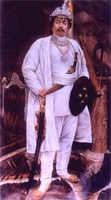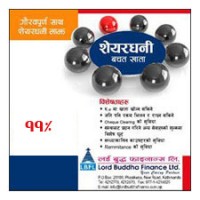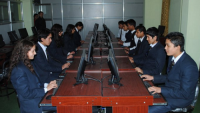The Reformist Dev Sumsher Rana
Born as the fourth of the seventeen sons to Chief of the Army Dhir Sumsher Rana (younger brother of Jang Bahadur Rana) and Rani Nanda Kumari, Dev Sumsher was a reformist. The huge family was difficult for the father and Sumsher brothers so, Dev Sumsher was adopted by his childless uncle General Krishna Bahadur Kunwar Ranaji. As the adopted child of General Ranaji, Dev Sumsher had a lavish upbringing similar to that of the Jung and other cousins. Because of which he spent more time at Thapathali Durbar with the sons of Jang Bahadur (he was close to) and met his own siblings only during the occasions like festivals or family gatherings. He had 12 sons and 3 daughters. He was married to Badamaharani Karma Kumari, Maharani Krishna Kumari (daughter of king Surendra, which made Dev Sumsher the only Sumsher brother among the 17 to marry a princess from royal family of Nepal) and Rani Ganesh Kumari.
The Sumsher family murdered many of their cousins, especially the sons of Jang Bahadur Rana and took over Nepal in a military coup d’état bringing the rule of Sumsher Rana family. They also murdered their uncle Sri Teen Maharaja Ranodip Singh and occupied the hereditary throne of Prime Minister and then, they added Jang Bahadur to their name. Although this entire coup was planned and executed by the Sumsher brothers, Dev Sumsher knew nothing about it because his brothers did not trust him as he had close relations with the Jang brothers. He was mistaken as a Jang brother and was almost killed the night of coup as he had slept at the residence of one of the Jang brothers. He was spared by the soldier who recognized him as a Sumsher. The remaining Rana families, apart from Sumsher were exiled and they took over the power of the country.
On March 5, 1901, he became the Prime Minister of Nepal at the age of 37 years after he claimed his heredity from his late brother Sri Teen Maharaja, Prime Minister Bir Sumsher Jang Bahadur Rana and received the ‘Laal Mohur’ (red stamp) of the then King of Nepal, King Prithvi Bir Bikram Shah. He kept his brother Fathe Sumsher Jang Bahadur Rana as Hajuriya General (Chief of the Prime Minister’s bodyguard) and his nephew General Gehendra Sumsher Jang Bahadur Rana in his post of spy-chief and head of police. He also appointed his brother Sher Sumsher as the Chief of Staff to the then King and even built a palace for him. In the year 1901 AD, he also appointed Sher Sumsher as the first director of Nepal’s first national newspaper Gorkhapatra which still is the government owned national daily.
He was impressed by the ‘Universal Education’ (Aksharanka Shiksha), a plan prepared by Jay Prithvi Bahadur Singh, King of Bajhang, which was later published in Gorkhapatra 1st and 2nd edition in 1901 AD. He was the kind of Prime Minister who was impressed with such works rather than empty flattery. It was during his time, that the iron ore mine was started in Thosay bazaar which is fifteen kilometers away in the north from Manthali, the headquarters of Ramechhap district. It was one of the Nepal’s largest iron ore and was used to manufacture weapons during the war with Tibet. He not only proclaimed ‘Universal Education’ but also began building schools, took steps to abolish slavery and introduced several other social welfare schemes along with making improvements to the arsenal at Nakkhu (south of Kathmandu). At the advice of his nephew General Gehendra Sumsher, he decided to establish parliament and built a big hall in his Thapathali Durbar like his uncle Prime Minister and Chief of the Army (Marshal) Jang Bahadur. He was also called ‘The Reformist’ for his works ad policies. He opened up the Durbar High School to the children of non-Rana clan as well and proposed a system of universal public primary education using Nepali as the language of instruction.
He also introduced a campaign in Kathmandu, Bhaktapur and Patan to fight corruption as well as introduced a cannon shot at midday to let people know the time. He organized ladies court, introduced newspaper to Nepal for the first time, made his Sindure Yatra royal proclamation eight times and in his short four month regime, he introduced gambling for two months along with bhajan from 3-5 pm and silent movies from 8-10 pm. He also wanted to send students to study in Japan, however, his short time as Prime Minister could not serve the purpose and the students were sent by the next Prime Minister, Chandra Sumsher in April 1902.
He was overthrown by his brothers just after four months of his reign as the Prime Minister and was exiled to India. He was first exiled to Dhankuta as the governor of East Nepal which is why he is also known as Dhankute Maharaj but later, he fled to Ilam and Darjeeling. His successor Chandra Sumsher made special request to the British to look after Dev so that he would stay away from matters related to Nepal and as a result, the British offered a large plot of land in New Delhi which is now known as the Connaught Palace/Circle. However, he refused the offer saying he would rather settle in cooler hills than Delhi and built a sprawling collection of grand buildings near Jharipani in Mussoorie. His residence, namely Fairlawn Palace now remains in ruins, however, a part of the estate has been developed for a school and residential purpose. The palace he lived in until his death was sold by his descendants later. All his children, although they were allowed to come back and forth to Nepal, were with him in exile and it was only during the reign of Juddha Sumsher, that they were allowed to return back to Nepal. Juddha Sumsher was his younger brother whom Dev and his wife karmakumari had taken care of as a father and mother and as a tribute to her Juddha Sumsher built a huge statue that stands at the central zoo, even today. It is the only biggest statue of any female in the country. The descendants of Dev Sumsher can be found either in the traditional Rana home in Thapathali, Kathmandu or in Nepalgunj in western Nepal and Dehradun in India.







